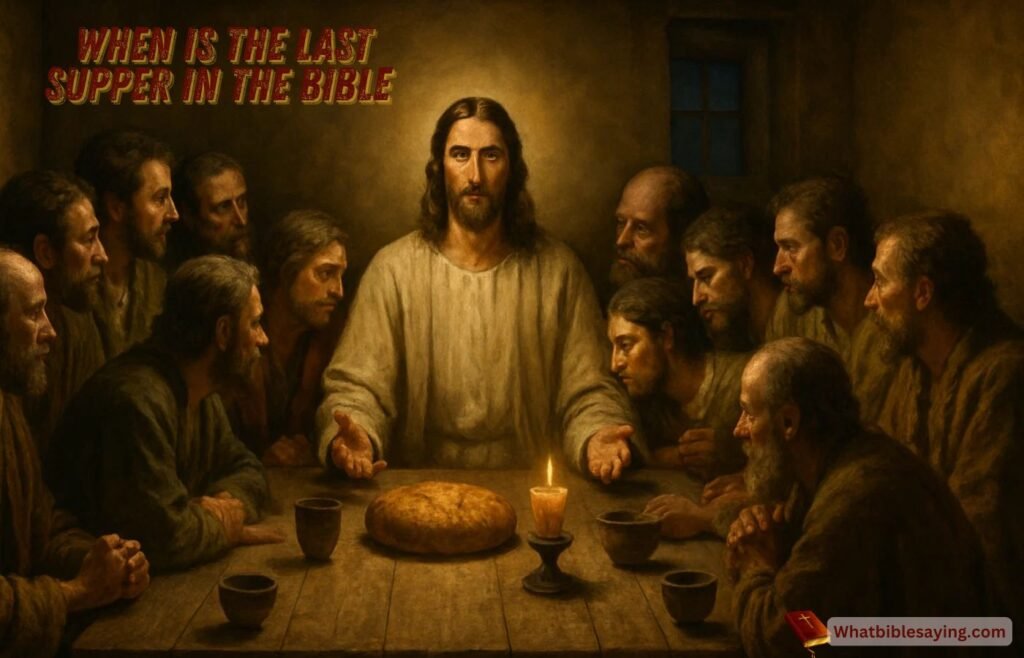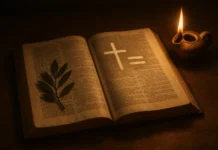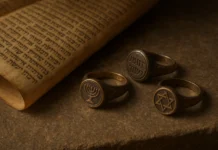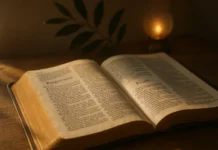 Introduction
Introduction
Few scenes in the Bible are as tender, solemn, and unforgettable as the Last Supper. It is the evening where Jesus gathered with His closest friends to share one final meal before walking toward the cross. For centuries, Christians have looked back on this moment with awe and reverence. The table where bread was broken and a cup was lifted has become the symbol of love, sacrifice, and the beginning of the covenant we celebrate today in Holy Communion.
But as we read the Gospels, one question often arises: When exactly was the Last Supper in the Bible? What day did it happen? Which chapters tell the story? Did it have any connection to superstitions like Friday the 13th? And what does the timing, the third, sixth, and ninth hours, teach us about how the Jewish people kept time and how Jesus’ final hours unfolded?
In this article, I want to walk with you through Scripture and history in a simple, clear way. Together, we’ll trace the timeline of the Last Supper, uncover the rich meaning behind the meal, and reflect on what it means for us today.
The Last Supper in the Bible
What chapter of the Bible is the Last Supper?
The story of the Last Supper is recorded in all four Gospels, though each writer tells it with slightly different details.
Matthew 26:17–30 describes the disciples preparing the Passover meal, Jesus predicting His betrayal, and then instituting the bread and cup as symbols of His body and blood.
Mark 14:12–26 closely follows the same pattern as Matthew, confirming the shared witness of the Synoptic Gospels.
Luke 22:7–38 offers additional dialogue, including Jesus’ touching words: “I have eagerly desired to eat this Passover with you before I suffer.”
John 13–17 takes a different path. Instead of focusing on the bread and wine, John tells us about Jesus washing the disciples’ feet, Judas leaving to betray Him, and the long, heartfelt farewell teachings known as the Upper Room Discourse.
Together, these chapters give us a full picture. We see the sacredness of the bread and cup, the humility of foot-washing, the sorrow of betrayal, and the hope of promises for the future.
The fact that all four Gospels describe this meal shows its importance. This was not just another dinner; it was the hinge of history, where Jesus revealed the depth of God’s love.
What day was the Last Supper in the Bible?
The Last Supper took place during the week of Passover, a holy festival when Jewish families remembered how God delivered them from slavery in Egypt. According to the Gospels, the meal happened on the evening when the Passover lambs were prepared, what Jewish tradition counts as the 14th of Nisan.
In Jewish timekeeping, a new day begins at sunset, not midnight. That means when Jesus sat down with His disciples in the evening, it was already considered the next day in the Jewish calendar. By our modern reckoning, the Last Supper happened on Thursday evening, and the crucifixion took place the following day, Friday, which we now remember as Good Friday.
This timing is vital. While Jewish families were preparing and eating lamb to remember their rescue from Egypt, Jesus, called the “Lamb of God who takes away the sin of the world”, was preparing to give His life. The timing was not coincidence; it was divine design.
The Timeline of the Last Supper
Did the Last Supper happen on Friday the 13th?
This question often comes up because of an old superstition about Friday the 13th being an unlucky day. Some people even say that the superstition began because there were 13 people at the Last Supper and that it happened on a Friday.
But history tells a different story. The Bible never uses our modern Gregorian calendar, which includes Friday the 13th. The Jewish people marked time according to lunar months and holy festivals, not numbered Fridays. So, the idea that the Last Supper was on Friday the 13th is not biblical, it’s a myth that developed centuries later in Western culture.
In reality, the Last Supper took place on a Thursday evening by modern reckoning, followed by Jesus’ arrest in Gethsemane that night, His trial, and His crucifixion on Friday. So, while 13 people sat at the table, and while Friday was the day of His death, the connection to “Friday the 13th” is a misunderstanding.
What is the 3rd, 6th, and 9th hour in the Bible?
When reading the story of Jesus’ trial and crucifixion, you may notice time references like “the third hour,” “the sixth hour,” and “the ninth hour.” Understanding these helps us grasp the flow of events around the Last Supper.
The Jewish day began at sunrise, roughly 6:00 a.m. in our terms. From there:
The third hour = about 9:00 a.m.
The sixth hour = about noon.
The ninth hour = about 3:00 p.m.
According to Mark 15:25, Jesus was crucified at “the third hour” (around 9:00 a.m.). From noon until 3:00 p.m., the sky grew dark (Mark 15:33). At about the ninth hour, He cried out, “My God, My God, why have You forsaken Me?” and then He breathed His last (Mark 15:34–37).
So, the Last Supper took place in the evening before all of this. After sharing bread and wine, Jesus and His disciples went to Gethsemane, where He prayed in agony until His arrest late that night. The time markers help us see how quickly the events moved from the table of fellowship to the cross of sacrifice.
The Meaning Behind the Meal
The institution of Communion (bread and wine)
At the heart of the Last Supper is the moment when Jesus took bread, gave thanks, broke it, and said, “This is my body given for you; do this in remembrance of me.” Then He took the cup and said, “This cup is the new covenant in my blood, which is poured out for you” (Luke 22:19–20).
With those words, He gave us the gift of Communion, also called the Lord’s Supper or the Eucharist. It is more than bread and wine; it is the symbol of His body and blood given for our salvation. Every time believers gather to take Communion, we proclaim the Lord’s death until He comes again.
The example of humility
John’s Gospel tells us that during the meal, Jesus rose, wrapped a towel around His waist, and washed His disciples’ feet (John 13:1–17). This act of humility shocked them. Peter even protested, saying, “You shall never wash my feet!”
But Jesus explained that He came not to be served, but to serve. By lowering Himself in this way, He showed us what leadership in God’s kingdom looks like: love expressed through humble service.
A table of betrayal and loyalty
The Last Supper was not only a place of comfort; it was also a table of testing. Jesus revealed that one of His disciples would betray Him. Judas quietly slipped away into the night. Peter, on the other hand, declared boldly that he would never deny Jesus, but before the rooster crowed, he would.
At that table, we see both human weakness and God’s mercy. Judas chose betrayal, but Peter was restored. It is a reminder to us all that even in our failures, God’s grace can lift us back up.
Why the Timing Matters for Believers Today
You may wonder: why does it matter exactly when the Last Supper happened? Isn’t the meaning more important than the date? That’s true, but the timing carries lessons, too.
The fact that the Last Supper took place on the evening of Passover shows us that Jesus is the ultimate Passover Lamb. Just as the lamb’s blood protected the Israelites in Egypt, so His blood covers us from sin and death.
The quick movement from supper to suffering reminds us that faith is not about comfort but about commitment. In just a few hours, the disciples went from reclining at the table to facing the shock of the cross. Life can change that quickly for us too, but God remains steady.
When we take Communion today, whether weekly or monthly, we join in remembering the same evening. The bread and cup tie us to that Thursday night in Jerusalem, making the past present and the promise future.
Conclusion
So, when was the Last Supper in the Bible? It took place on the evening before Jesus’ crucifixion, during the Passover festival, most likely on what we would call Thursday night, recorded in Matthew 26, Mark 14, Luke 22, and John 13. It was not on Friday the 13th, but on the sacred evening when the Lamb of God prepared to lay down His life.
That night was filled with teaching, betrayal, love, humility, and above all, hope. The bread and wine pointed forward to the cross and resurrection. The timing tied Jesus to the Passover story. And the hours that followed revealed the depth of His obedience to the Father.
As believers today, we honor the Last Supper not only by knowing when it happened, but by remembering why. Every time we gather at the Lord’s Table, we proclaim His love, His sacrifice, and His promise: “Do this in remembrance of Me.”













